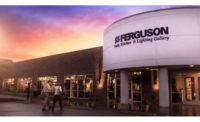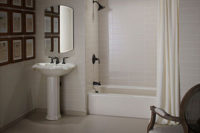Feature
How changing consumer habits are impacting preferences in homes
Multi-generational spaces and personalization lead the way in kitchen and bath.

Images courtesy of Moen
The way we utilize our homes is constantly changing. According to a recent Moen survey*, 42% of U.S. homeowners cite hosting as a reason to spend quality time with loved ones. As the desire for more intimate gatherings grows and nights out decrease, creating a space that supports the needs of both hosts and visitors becomes increasingly important.
Here are key considerations that professionals must keep in mind when designing for homeowners who host often.
The right layout
An ideal layout for entertaining embraces elements that allow for a smooth workflow for hosts and a comfortable environment for guests.
Floor plans that offer practicality and enable easy movement throughout the home – such as open concepts, a great room with a defined dining area, or a kitchen with a serving space as well as seating – remain popular choices for hosts. These layouts are ideal for gatherings as they encourage connection between the cooking, dining, and living areas to create a sense of togetherness and allow guests to chat easily and move freely between spaces, while also enabling the host to engage with guests even during the cooking or serving process.
Intentional appliance placement also can have astounding impact. The concept of the work triangle, which places the refrigerator, sink, and stove in close proximity, minimizes unnecessary steps and allows seamless movement between these essential zones, reducing stress on hosts.

By understanding the specific needs of the modern host, professionals can create spaces that facilitate memorable, enjoyable and stress-free gatherings.

To help minimize clutter – and maximize countertop space,, professionals may want to opt for multi-functional elements, like a workstation sink.
Choosing where to place the cooktop or range is an important choice, too. For hosts who spend most of their time prepping, they may want to place the sink in an island that also offers seating – so they can mingle with guests while chopping and slicing – but place the cooktop elsewhere in the kitchen, to leave more counter space for serving food or guests to sit and chat or eat.
To help minimize clutter – and maximize countertop space, which can quickly become messy during food preparation and serving – professionals may want to opt for multi-functional elements, like a workstation sink. These products help expand the work area and provide an all-in-one prep and cleanup space, so hosts can keep counters free of mess. Incorporating a garbage disposal also can streamline and simplify cleanup, allowing for quick and sustainable disposal of scraps right into the sink.
Enhancing multi-generational experiences
The routine host also frequently welcomes guests from varying generations, whether it’s young children or aging grandparents. This presents an opportunity for professionals to make recommendations that can mindfully accommodate a variety of ages, preferences, and necessities so every guest is comfortable in a home.
One key area to consider is planning the best built-ins and furniture choices. Height-adjustable work surfaces and cabinets can be a game-changer for users of different heights and abilities. Meanwhile, seating options may cater to different age groups, like bar stools for adults, benches for children, and chairs for those with more limited mobility or who need stronger support.
And, pros shouldn’t hesitate to consider how technology can be used to support varying needs in the kitchen, both for the host and guests. For example, a smart faucet with touchless voice activation is useful for an array of ages and stages. Busy cooks who don’t want to touch the faucet after cutting raw meat will love hands-free features, while models with timed handwashing presets help promote hygiene for young guests. Touchless faucets also are easier to use for those with limited mobility.
Personalizing spaces that impress
At the end of the day, homeowners want spaces that not only function well, but also look beautiful and express their personal style to their guests. In fact, the survey from Moen revealed that 80% of respondents deemed personalization important to them.*
One of the simplest yet most impactful ways professionals can help homeowners express their individuality is through color palette. Pros should work with clients to think about not just the wall color, but the entire scheme of the space, including cabinets, tile and grout selection, and fixture finishes. The space’s color aesthetic helps reflect the tastes of the homeowner and can even create conversation pieces to spark moments of engagement with guests.



In addition to choosing colors that express their own style, it’s also important for hosts to share with a pro how they’ll be using a space so the colors make sense for their lifestyle. For instance, a home that’s often filled with young kids may want to shy away from white cabinets that easily get dirty as well as opt for spot-resistant fixture finishes to maintain a clean appearance.
The good news is that hosts don’t have to choose between modern conveniences and embracing their own personal aesthetic, with many top-of-the-line products from stoves to refrigerators and more available in an array of design styles and colors. For example, for those who like a classic look, many traditional faucets come in contemporary finishes like Matte Black while also offering smart technology or enhanced spray functionality for quicker rinsing or filling of pots for cooking – showing off a host’s style, while making food prep and cleanup easier.
That being said, personalization isn’t just about aesthetics – it’s about how a client uses a space, too. Pros should make sure to ask the right questions so they can align on the right personal touches to make the space as functional as possible for homeowners. For example, for the avid cook, a pot filler not only eliminates the need to move around the kitchen but also emphasizes style and adds color, while a health enthusiast who is passionate about water quality would reap the benefits of integrating a water filtration system for use by their family and their guests. Someone with a large family may want double ovens to prep a big Thanksgiving meal, or cocktail enthusiasts may want a second sink with a bar faucet in the living area to prep drinks for happy hour soirees.
As pros work with their clients, it’s important to keep in mind that the design of a home profoundly impacts the entire entertaining experience. By understanding the specific needs of the modern host, professionals can create spaces that facilitate memorable, enjoyable and stress-free gatherings.
*Data from the 2024 Moen Homeowner Trends Survey
Looking for a reprint of this article?
From high-res PDFs to custom plaques, order your copy today!







